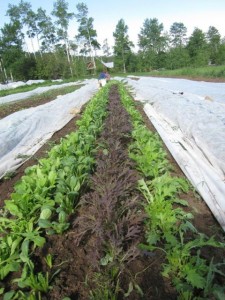
(information from Eating on the Wild Side, by Jo Robinson)
We all understand the importance of greens in our diet, but did you know lettuce and other salad greens have greater or lesser health benefits, according to their color, type, and freshness? By learning a few things to look for when selecting your leafy greens, you can come home with nutrition-packed produce.
Lettuce is a great source of nutrition, and many head lettuces have large amounts of phytonutrients. Phytonutrients are chemicals produced by the plant, to help it in protection from bugs, fungi, germs and other threats. Many phytonutrients are strong antioxidants in humans, and have other beneficial contributions to our well being, such as fighting the flu.
Head lettuce varieties that have the most benefits have two characteristics. Dark colored lettuce, (especially red), is the best choice for nutrition, so pick red or dark green colors first. Second, loose-leaf lettuces have higher amounts of phytonutrients than densely packed heads, as they are more exposed to the sun with their open form. The sun causes them to produce more antioxidants to protect against UV rays! Romaine and Bibb lettuces have moderate amounts of phytonutrients and would be the next pick after looseleaf. Iceberg lettuce, despite being a familiar, favored choice of many American homes and salad bars, has the least nutritional value among lettuces.
Other greens including arugula, spinach, radicchio, and endive have even higher amounts of phytonutrients than lettuce, and can add different textures and flavors to salad. Bitterness is a sign of more beneficial nutrition! If you can’t tolerate bitter flavors, mix them in with milder lettuces. Pre-cut salad mixes are also loaded with nutrition, especially mixes with darker greens.
Over time, greens will lose their nutritional value, thus the fresher the better. That is one of the great things about getting your leafy produce at the farmers market—you can ask the farmer when the greens were harvested—preferably within the last day or so. You can also examine for yellowed leaves.
It is also important to store greens correctly. Wash and dry off your produce right when you get home. Storing with some, but not too much moisture, in a plastic bag with small holes, will ensure the happiest and longest lasting greens. Head lettuce will easily keep a week or more if washed and stored correctly; cut salad greens should last up to a week.
